
Materials:
• Student files from Week 11 (“FullSong1”)
• Computer with internet connection and speakers
• Song example featuring an Intro
(Suggestion: “Empire State of Mind” by Jay Z and Alicia Keys)
Discussion:
In the last few lessons we worked on creating Verse and Chorus sections for our beats.
Recap:
• What is a Verse and how long is it usually in modern pop music?
• What is a Chorus and how long is it usually?
New question – how many Verses and Choruses do you usually have in a song?
To help us get some ideas about this, everyone is going to listen to a whole song all the way though and count the number of Verses and Choruses. Two other things to listen for:
• How does the song start?
• Are there any other parts that are different than the Verse and Chorus?
(Instructor: As a class, listen to beginning of a song and identify Chorus. Then, have students listen to the entire song individually on headphones, or as a class, and count Verses/Choruses. After listening, have a group discussion to see how many they were able to count. Play back Intro section and have students break it down – instruments, feeling, etc. Song suggestion: “Empire State of Mind” by Jay-Z and Alicia Keys.)
So, as we just heard, there is another part of a song that is very important to the way a song hits the listener…
The Intro
1. Is the opening to the song.
2. Purpose is to build suspense and anticipation for the song to really get going (the first Verse or Chorus)
3. A common technique for making an Intro is to start with just the drums, or just the melody. This makes the listener wait for the missing parts and makes it more exciting when the other instruments come in.
4. Is often 4-8 bars long.
So now you are going to do a few things with your beat:
1. Copy the Verse and Chorus so that you have enough parts for a full song
2. Add an Intro section
3. (If you have time) change something in the 2nd and 3rd Verse to make the whole song more interesting.
Please do the following:
Part 1
First, let’s turn our “beats” into a “SONGS” by copying the Verse and Chorus 2 times…
1. Zoom out (press G on keyboard) so that you can see your whole beat in the Sequencer.
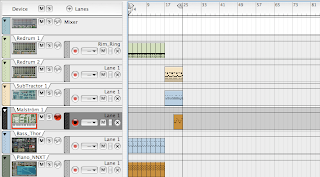
2. In the Sequencer, find an empty spot above and to the right of your Chorus section. Click and drag the mouse downwards and to the left so that you see a box around the Verse and Chorus sections. Let go of the mouse button.
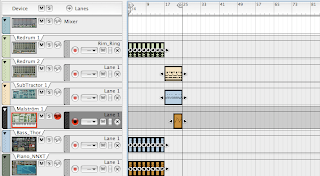
3. Everything should now be highlighted. Hold down the OPTION/ALT key on your keyboard. Click anywhere in the beat and drag it to the right. Line the copy up so that the Verse starts on Bar 25 and let go of the mouse button.
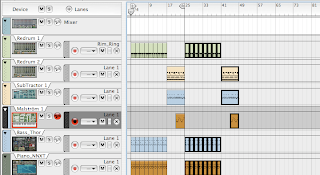
4. The Verse and Chorus copy should still be highlighted. Hold down OPTION/ALT and click and drag another copy to start on Bar 49.
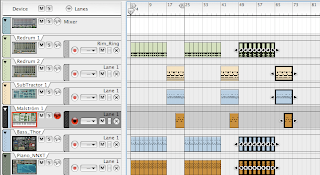
5. The beat should now end on Bar 73. Congratulations, you just made a whole song!!!
6. Save the song as: your name_FullSong1
7. Have the instructor listen to your song.
8. Save again!!!
(Instructor: For advanced students who finish early, encourage them to revisit one of their earlier beats and build into a Verse/Chorus structure.)
Part 2
Now we will make an Intro to the song.
1. First we need to grab and highlight everything. Remember how to do this? Just click and drag a box around everything…
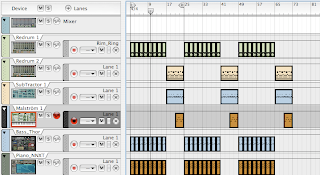
2. With everything highlighted, click inside one of the regions and drag everything to the right. Make it so that everything starts on Bar 9. Be careful not to drag on the little arrows at the ends of the regions!
3. Click in a blank part of the Sequencer to unhighlight everything.
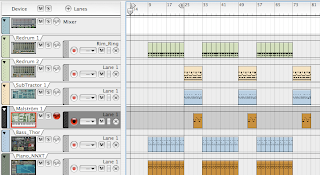
4. Now pick one of the instruments that you want to use for the Intro. Hold down ALT/OPTION on your keyboard and click and drag the region to the beginning of the song.
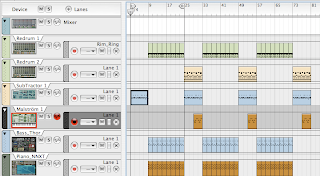
5. Play it back and listen to it. Is it good? Would a different instrument be better in this part? Would it help to add a new instrument? What can you do to make this a good start to your song?
6. SAVE.
7. Have the instructor listen and give you feedback.
(Instructor: Encourage students to put effort into making their Intros exciting. Suggestions include adding a few extra drum sounds (e.g cymbals), or adding an extra instrument at the end of the Intro right before the first Verse starts.)
Part 3 (time permitting)
Because we don’t have a singer or MC on our songs right now, the Verses might sound a little repetitive. We can help change this by switching the instruments up in each Verse. Here’s a quick and easy way to do it…
1. Create a new melodic instrument (NN19, Subtractor, Malstrom, etc.).
2. Now highlight the 2nd Verse of one of the other instruments.
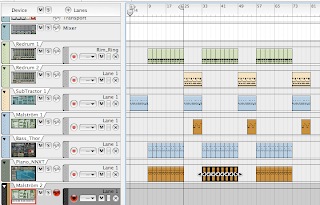
3. Drag it onto the track of the new instrument.
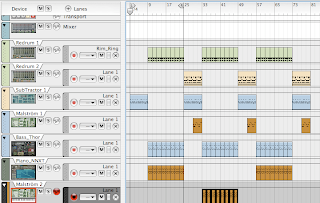
4. While the regions are still highlighted, hold down ALT/OPTION and drag a copy of the regions over to Verse 3.
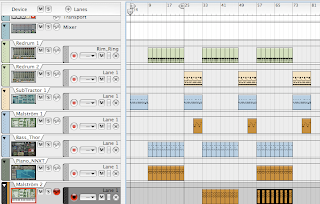
5. Play Verse 2 and listen to the sound of the new instrument.
6. If you want to change it, click on the Browse Patch button and load another sound.
7. Now check Verse 3 to see if it sounds good with both instruments playing. If it doesn’t sound good, what can you change?
8. SAVE.
9. Have the instructor listen to your work.
(Instructor: Make sure student work is saved and backed up for use in Week 12 Lesson 2. Advanced students can be allowed to work ahead on next lesson.)
Resources:
1. www.looknohands.com - scale finder
2. www.youtube.com - online videos
3. www.grooveshark.com - music library
No comments:
Post a Comment